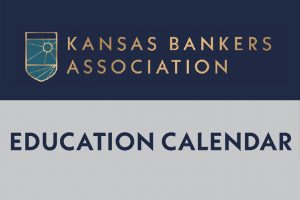Increased enforcement of regulations requiring federal contractors to keep an affirmative action plan on file has implications for Kansas banks.
Financial institutions that are issuing and paying agents for U.S. savings bonds and savings notes in any amount are required under the Office of Federal Contract Compliance Programs (OFCCP) to have an affirmative action plan and also certify through that organization’s contractor portal.
Federal contractor requirements such as these are not new. However, the recent push to have affirmative action plans
certified through the OFCCP has some bank leaders realizing that they may not be in compliance with this particular
employment law.
Connor Cross, Director of Human Resources for Syndeo, says having an affirmative action plan is more than just checking a box on the OFCCP portal. Syndeo is an outsourced human resources provider.
“A compliant affirmative action plan has many different elements including required postings in the workplace, specific
language on all job postings, self-identification language on applications, a written affirmative action plan and workforce
analysis reporting,” Cross says. “The affirmative action plan is a living document that will need to be updated yearly based on the annual workforce analysis, changing demographics in the recruiting area and the company’s specific recruitment plan.”
This regulation applies to organizations with 50 or more employees. Banks that are nearing that threshold should plan accordingly to ensure they are in compliance. That may require incorporating an applicant tracking system and electronic onboarding processes to capture this data if these platforms aren’t already in place at your bank.
Affirmative action requirements
The affirmative action plan requirement also factors in the amount of the contract with the federal government. Executive Order 11246 and Section 503 of the Rehabilitation Act of 1973 set that amount at $50,000. The Vietnam Era Veterans’ Readjustment Assistance Act of 1974 utilizes a $150,000 government contract amount.
Executive Order 11246, which was enacted in 1965 and has been amended and strengthened over the years, is a commonly cited equal employment opportunity law. A bank is considered a federal contractor under that law if 1. It has a bona fide federal contract; 2. It is a fund depository; 3. It processes U.S. savings bonds.
However, the latter has become less of a qualifying factor. Gordon Berger, a partner at the law firm FisherBroyles LLP,
says processing U.S. savings bonds typically has been a criterion that classified almost all banks as federal contractors.
He says that is no longer the case since savings bond processing is now done electronically through the Federal Reserve Board.
In general, affirmative action plans should cover how an organization handles recruiting, hiring and promotion of women and minorities. The Society for Human Resource Management notes courts also could require an affirmative action program for instances where discrimination has been deemed to have occurred or if a company has a history of
discriminatory practices.
The U.S. Department of Labor says federal contractors and subcontractors must take affirmative action to “recruit and
advance qualified minorities, women, persons with disabilities and covered veterans.” The organization also recommends affirmative action programs include training programs, outreach efforts and other proactive measures.
Additionally, Federal Reserve banks are not subject to OFCCP equal employment opportunity and affirmative action laws by virtue of being a federal entity and not a contractor.
Other regulations
Hitting the 50-employee milestone is a trigger for other compliance-related regulations in addition to having an
affirmative action plan.
Here’s some employment laws to consider when your bank is at or near that 50-employee threshold.
- The Family and Medical Leave Act – This law applies to private sector employers with 50 or more employees and requires employees to be provided up to 12 weeks of unpaid, job-protected leave per year.
- Affordable Care Act – Employers with 50 or more employees are subject to certain information-reporting and health care insurance provisions.
- EEO-1 Reporting – This U.S. Equal Employment Opportunity Commission report tracks employees by job category and separately by ethnicity, race and gender. It is required for all federal contractors with 50 or more
employees. - VETS Reporting – This is an extension of a general affirmative action plan and applies to federal contractors or
subcontractors worth $150,000 or more. The annual report tracks an employer’s efforts to employ protected veterans.
Also, be mindful of applicable state laws for employers with 50 or more employees. Certainly, responsibilities for compliance with employment law regulations can be kept in-house. However, working with an outsourced provider may be a more suitable alternative to understanding and navigating complex compliance-related regulations if in-house solutions are not feasible or desirable for your bank.

Syndeo is an industry-leading outsourced human resources provider serving banks across Kansas. Our strategy is to ensure clients have the tools and resources they need to achieve and maintain compliance with the HR-related aspects of employment law requirements. Contact us to learn more about our services.
About the author: Josh Heck is Syndeo’s marketing manager. Reach him at jheck@syndeohro.com or at (316) 440-9940.









